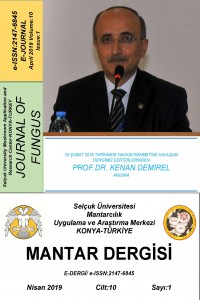Abstract
Muğla’dan
yeraltı mantarı, Balsamia vulgaris Vittad. toplandı. Bu tür
peridyal siğilleri, üç yağ damlalı uzun ve eliptik sporlarıyla karakterizedir. Balsamia cinsi gerçek trüflerle beraber
yetişmekte ve çoğunlukla sonbahar ve kış aylarında büyümektedir.
Keywords
References
- Doğan H.H., Bozok F., Taşkın H., A new species of Barssia (Ascomycota, Helvellaceae) from Turkey, Tr J of Bot., 42: 636-643 (2018).Gori L., Funghi ipogei della Lucchesia, Marlia, Lucca: Maria Pacini Fazzi Editore (2005).Index Fungorum (2018). http://www.indexfungorum.org/Names/Names.asp. Accessed 30 October 2018.Montecchi A., Sarasini M., Funghi ipogei d’europa, A.M.B.Fondazione Centro Studi Micologici, Vicenza, Italy (2000).Sesli E., Denchev CM., Checklists of the myxomycetes, larger ascomycetes, and larger basidiomycetes in Turkey. Mycotaxon 106: 65–67 (2008). + online version 2014: 1-136.Southworth D., Frank J.L., Castellano M.A., Smith M.E., Trappe J.M., Balsamia (Sequestrate Helvellaceae, Ascomycota) in western North America, Fungal Systematics and Evolution, 2: 11–36 (2018).
- Gori L., Funghi ipogei della Lucchesia, Marlia, Lucca: Maria Pacini Fazzi Editore (2005).
- Index Fungorum (2018). http://www.indexfungorum.org/Names/Names.asp. Accessed 30 October 2018.
- Montecchi A., Sarasini M., Funghi ipogei d’europa, A.M.B.Fondazione Centro Studi Micologici, Vicenza, Italy (2000).
- Sesli E., Denchev CM., Checklists of the myxomycetes, larger ascomycetes, and larger basidiomycetes in Turkey. Mycotaxon 106: 65–67 (2008). + online version 2014: 1-136.
- Southworth D., Frank J.L., Castellano M.A., Smith M.E., Trappe J.M., Balsamia (Sequestrate Helvellaceae, Ascomycota) in western North America, Fungal Systematics and Evolution, 2: 11–36 (2018).
Abstract
A hypogeous fungus Balsamia
vulgaris Vittad. was collected from
Muğla. This species is well characterised by its peridial warts, long and
elliptical spores with three oil drops. Balsamia
genus grows together with true truffles and they can frequently found in autumn
and winter.
Keywords
References
- Doğan H.H., Bozok F., Taşkın H., A new species of Barssia (Ascomycota, Helvellaceae) from Turkey, Tr J of Bot., 42: 636-643 (2018).Gori L., Funghi ipogei della Lucchesia, Marlia, Lucca: Maria Pacini Fazzi Editore (2005).Index Fungorum (2018). http://www.indexfungorum.org/Names/Names.asp. Accessed 30 October 2018.Montecchi A., Sarasini M., Funghi ipogei d’europa, A.M.B.Fondazione Centro Studi Micologici, Vicenza, Italy (2000).Sesli E., Denchev CM., Checklists of the myxomycetes, larger ascomycetes, and larger basidiomycetes in Turkey. Mycotaxon 106: 65–67 (2008). + online version 2014: 1-136.Southworth D., Frank J.L., Castellano M.A., Smith M.E., Trappe J.M., Balsamia (Sequestrate Helvellaceae, Ascomycota) in western North America, Fungal Systematics and Evolution, 2: 11–36 (2018).
- Gori L., Funghi ipogei della Lucchesia, Marlia, Lucca: Maria Pacini Fazzi Editore (2005).
- Index Fungorum (2018). http://www.indexfungorum.org/Names/Names.asp. Accessed 30 October 2018.
- Montecchi A., Sarasini M., Funghi ipogei d’europa, A.M.B.Fondazione Centro Studi Micologici, Vicenza, Italy (2000).
- Sesli E., Denchev CM., Checklists of the myxomycetes, larger ascomycetes, and larger basidiomycetes in Turkey. Mycotaxon 106: 65–67 (2008). + online version 2014: 1-136.
- Southworth D., Frank J.L., Castellano M.A., Smith M.E., Trappe J.M., Balsamia (Sequestrate Helvellaceae, Ascomycota) in western North America, Fungal Systematics and Evolution, 2: 11–36 (2018).
Details
| Primary Language | English |
|---|---|
| Journal Section | MYCOLOGY |
| Authors | |
| Publication Date | April 25, 2019 |
| Published in Issue | Year 2019 Volume: 10 Issue: 1 |
The works submitted to our journals are first judged grammatically. After this phase, articles are sent two reviewers. If necessary, the third reviewer is assessed. In the publication of works, a decision is made by evaluating the level of contribution to science and readers within the criteria specified in the writing rules. Reviewers are requested to submit their assessments within 30 days at the latest. The reviewers' evaluations and the answers to these evaluations are reviewed by the editor and it is decided whether the work will be published or not.
International Peer Reviewed Journal
The journal doesn’t have APC or any submission charges

This work is licensed under a Creative Commons Attribution 4.0 License


